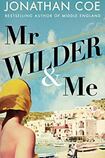
In a 2002 feature piece for the Observer Magazine, British writer Jonathan Coe revealed that his biggest influence wasn’t a fellow novelist, but film director Billy Wilder. It was the combination of “desperate sadness” and “unapologetic levity”, the “lurch from comedy to pathos”, that shaped Coe’s own artistic consciousness, he wrote. His seminal experience with Wilder’s work was The Private Life of Sherlock Holmes (1970) , an affectionate send-up of Arthur Conan Doyle’s famous detective.
This is significant information for anyone approaching Mr Wilder & Me, whose subtitle might well be The Adventures of a Greek Interpreter, one of Conan Doyle’s favourite Holmes stories. Late in his novel, Coe drops the title into a conversation between Wilder and the book’s narrator, Calista, an aimless Greek student with musical flair who finds herself drawn into the film world when she is employed as an interpreter to the director and assistant to his collaborator, IAL Diamond, on the set of Wilder’s penultimate film, Fedora (1978).
The book opens in present-day London, where Calista is working on a score inspired by her historic relationship with the director. Calista is, like the Wilder we meet in her recollections, at the ignominious end of her own career. Having achieved some success as a film composer, she is now unable to get a commission: her Wilder piece is a consoling memory piece, as well as a study of mutual sadness at their falling status.
Calista’s first encounter with Wilder in Los Angeles is happenstance, but her naivety and quiet openness to experience becomes her calling card. She is “an oasis of sanity in all [the] madness” of Hollywood culture, and when Wilder finds himself in Europe, she is called upon to work for him and Diamond. Calista is working for Coe, meanwhile, as a narrative device: she is a blank slate upon which Wilder’s narrative can be projected; an inert ear to which Diamond and Wilder confess their innermost ambitions, grievances and griefs.
Chief among them is the director’s dying reputation. Unable to find funding in the US for Fedora, Wilder is filming in Europe because German investors are putting up the money. “If it’s a huge success,” he says with more truth than joviality, “it will be my revenge on Hollywood. If it’s a flop it will be my revenge for Auschwitz”.
Coe further elaborates Wilder’s precarious position by illuminating tensions between classic Hollywood and the new realism being ushered in by Martin Scorsese and Steven Spielberg in the late 1970s. Aspiring film director Matthew, who is also Calista’s love interest, serves this role. He wants to smash the “massive, complicated gilded frame” of Wilder’s generation, he tells Calista, conveniently expository in his ambition. He wants to present the world as it is: “plain, and simple, and crystal clear”.
Revelatory denial
Calista, meanwhile, is a lightly-sketched character. Despite her centrality in the story, her private life is portrayed with the suggestive evasiveness of another referenced film director’s calling card: Ernst Lubitsch’s locked door. This strategy of revelatory denial chimes with Wilder’s own storytelling techniques as he describes them: “You don’t make things obvious. You imply things. You use a bit of subtlety, you make the audience do the work.” But while this technique can work effectively and humorously on film, and is appropriate for a suspense-driven novel, it does not work here.
Coe does offer glimpses of Calista’s interior life. Her two children and husband make a fleeting appearance; we see her smarting at her falling professional standing; and Coe concludes the book by showing her dignified re-entry to domestic life, a contrast to Wilder’s long fight to keep getting films made. However, these aspects are dead on the page, as are the rather prosaic descriptions of the role music plays in Calista’s life.
There is a slight possibility that Calista’s limp characterisation is deliberate: like most female characters in Wilder’s oeuvre, she fails the Bechdel test. Such a tricksy intertextual tribute may please Wilder’s fans, but not Coe’s.
There are other instances where Coe integrates clever filmic techniques more successfully. The stylistic rupture that occurs when Calista breaks from straightforward narrative presentation to present an extended expository flashback in script form is extremely effective. This scene is key in establishing Wilder’s desire to return to Europe and the unusually melancholic tone of Fedora, as he tries to take account of his family’s dark history and his mother’s fate during the second World War.
The outsider characters, meanwhile, give Coe plenty of scope to engage with the political themes that readers most associate with his extensive satirical oeuvre, from What a Carve Up! to Middle England. Who better to observe the paradoxes of postcolonial and (in the contemporary context of the book’s writing) post-Brexit Britain than foreigners? Calista, Wilder and Diamond variously describe Britain as “not Europe”, with its “island mentality” and “its strange people, with their strange ways of pronouncing words and their strange codes of behaviour and their strange class system... its occult, eccentric, indeed, incomprehensible customs”.
However, Coe’s usual cohort of fans will otherwise be bemused by the inconsistent style and tone of Mr Wilder & Me, much as contemporary audiences and critics were bemused by the ill-fated Fedora.












